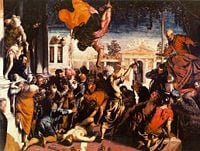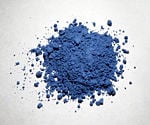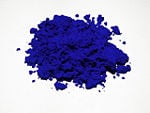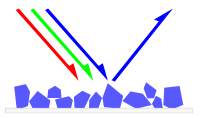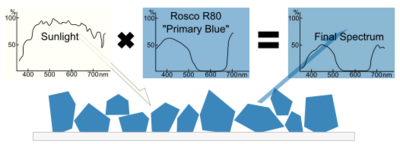Pigment
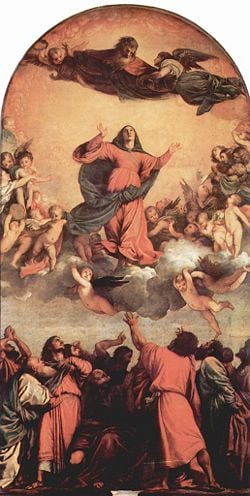
A pigment is a material that changes the color of light it reflects as the result of selective color absorption. This physical process differs from fluorescence, phosphorescence, and other forms of luminescence, in which the material itself emits light. Many materials selectively absorb certain wavelengths of light. Materials that humans have chosen and developed for use as pigments usually have special properties that make them ideal for coloring other materials. A pigment must have a high tinting strength relative to the materials it colors. It must be stable in solid form at ambient temperatures.
For industrial applications, as well as in the arts, permanence and stability are desirable properties. Pigments that are not permanent are called fugitive pigments. They fade over time, or with exposure to light, while some eventually blacken.
Pigments are used for coloring paint, ink, plastic, fabric, cosmetics, food, and other materials. Most pigments used in manufacturing and the visual arts are dry colorants, usually ground into a fine powder. This powder is added to a vehicle (or matrix), a relatively neutral or colorless material that acts as a binder.
Pigments versus dyes
Both pigments and dyes appear colored because they absorb some wavelengths of light preferentially. Yet, a distinction is usually made between a dye and a pigment. A dye is either a liquid or is soluble in its vehicle (such as water), resulting in a solution. By contrast, a pigment is insoluble in the vehicle, resulting in a suspension. In addition, a dye binds to the substrate, but a pigment generally has no affinity for the substrate.
A colorant can be both a pigment and a dye depending on the vehicle it is used in. In some cases, a pigment can be manufactured from a dye by precipitating a soluble dye with a metallic salt. The resulting pigment is called a lake pigment.
History
Naturally occurring pigments such as ochres and iron oxides have been used as colorants since prehistoric times. Archaeologists have uncovered evidence that early humans used paint for aesthetic purposes such as body decoration. Pigments and paint grinding equipment believed to be between 350,000 and 400,000 years old have been reported in a cave at Twin Rivers, near Lusaka, Zambia.
Before the Industrial Revolution, the range of color available for art and decorative uses was technically limited. Most of the pigments in use were earth and mineral pigments, or pigments of biological origin. Pigments from unusual sources such as botanical materials, animal waste, insects, and mollusks were harvested and traded over long distances. Some colors were costly or impossible to mix with the range of pigments that were available. Blue and purple came to be associated with royalty because of their expense.
Biological pigments were often difficult to acquire, and the details of their production were kept secret by the manufacturers. Tyrian Purple is a pigment made from the mucus of one of several species of Murex snail. Production of Tyrian Purple for use as a fabric dye began as early as 1200 B.C.E. by the Phoenicians, and was continued by the Greeks and Romans until 1453 C.E., with the fall of Constantinople.[1] The pigment was expensive and complex to produce, and items colored with it became associated with power and wealth. Greek historian Theopompus, writing in the fourth century B.C.E., reported that "purple for dyes fetched its weight in silver at Colophon [in Asia Minor]."[2]
Mineral pigments were also traded over long distances. The only way to achieve a deep rich blue was by using a semi-precious stone, lapis lazuli, and the best sources of lapis were remote. Flemish painter Jan Van Eyck, working in the fifteenth century, did not ordinarily include blue in his paintings. To have one's portrait commissioned and painted with blue was considered a great luxury. Patrons who wanted blue were forced to pay extra. When Van Eyck used lapis, he never blended it with other colors. Instead he applied it in pure form, almost as a decorative glaze.[3]
Spain's conquest of a New World empire in the sixteenth century introduced new pigments and colors to peoples on both sides of the Atlantic. Carmine, a dye and pigment derived from a parasitic insect found in Central and South America, attained great status and value in Europe. Produced from harvested, dried, and crushed cochineal insects, carmine could be used in fabric dye, body paint, or in its solid lake form, almost any kind of paint or cosmetic.
Natives of Peru had been producing cochineal dyes for textiles since at least 700 C.E.,[4] but Europeans had never seen the color before. When the Spanish invaded the Aztec empire in what is now Mexico, they were quick to exploit the color for new trade opportunities. Carmine became the region's second most valuable export next to silver. Pigments produced from the cochineal insect gave the Catholic cardinals their vibrant robes and the English "Redcoats" their distinctive uniforms. The true source of the pigment, an insect, was kept secret until the eighteenth century, when biologists discovered the source.[5]
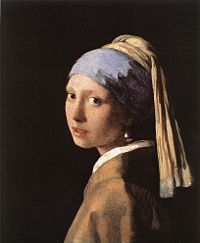
While Carmine was popular in Europe, blue remained an exclusive color, associated with wealth and status. The seventeenth-century Dutch master Johannes Vermeer often made lavish use of lapis lazuli, along with Carmine and Indian Yellow, in his vibrant paintings.
Development of synthetic pigments
The Industrial and Scientific Revolutions brought a huge expansion in the range of synthetic pigments, pigments that are manufactured or refined from naturally occurring materials, available both for manufacturing and artistic expression. Because of the expense of Lapis Lazuli, much effort went into finding a less costly blue pigment.
Prussian Blue was the first synthetic pigment, discovered by accident in 1704. By the early nineteenth century, synthetic and metallic blue pigments had been added to the range of blues, including French ultramarine, a synthetic form of lapis lazuli, and the various forms of cobalt and Cerulean blue. In the early twentieth century, organic chemistry added Phthalo Blue, a synthetic, organic pigment with overwhelming tinting power.
Discoveries in color science created new industries and drove changes in fashion and taste. The discovery in 1856 of mauveine, the first aniline dye, was a forerunner for the development of hundreds of synthetic dyes and pigments. Mauveine was discovered by an 18-year-old chemist named William Henry Perkin, who went on to exploit his discovery in industry and become wealthy. His success attracted a generation of followers, as young scientists went into organic chemistry to pursue riches. Within a few years, chemists had synthesized a substitute for madder in the production of Alizarin Crimson. By the closing decades of the nineteenth century, textiles, paints, and other commodities in colors such as red, crimson, blue, and purple had become affordable.[6]
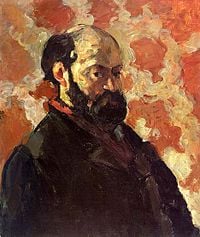
Development of chemical pigments and dyes helped bring new industrial prosperity to Germany and other countries in northern Europe, but it brought dissolution and decline elsewhere. In Spain's former New World empire, the production of cochineal colors employed thousands of low-paid workers. The Spanish monopoly on cochineal production had been worth a fortune until the early 1800s, when the Mexican War of Independence and other market changes disrupted production. Organic chemistry delivered the final blow for the cochineal color industry. When chemists created inexpensive substitutes for carmine, an industry and a way of life went into steep decline.[7]
New sources for historic pigments
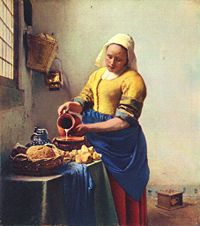
Before the Industrial Revolution, many pigments were known by the location where they were produced. Pigments based on minerals and clays often bore the name of the city or region where they were mined. Raw Sienna and Burnt Sienna came from Sienna, Italy, while Raw Umber and Burnt Umber came from Umbria. These pigments were among the easiest to synthesize, and chemists created modern colors based on the originals that were more consistent than colors mined from the original ore bodies. But the place names remained.
Historically and culturally, many famous natural pigments have been replaced with synthetic pigments, while retaining historic names. In some cases the original color name has shifted in meaning, as a historic name has been applied to a popular modern color. By convention, a contemporary mixture of pigments that replaces a historical pigment is indicated by calling the resulting color a hue, but manufacturers are not always careful in maintaining this distinction. The following examples illustrate the shifting nature of historic pigment names:
- Indian Yellow was once produced by collecting the urine of cattle that had been fed only mango leaves. Dutch and Flemish painters of the seventeenth and eighteenth centuries favored it for its luminescent qualities, and often used it to represent sunlight. In Girl with a Pearl Earring, Vermeer's patron remarks that Vermeer used "cow piss" to paint his wife. Since mango leaves are nutritionally inadequate for cattle, the practice of harvesting Indian Yellow was eventually declared inhumane. Modern Indian Yellow Hue is a mixture of synthetic pigments.
- Ultramarine, originally the semi-precious stone lapis lazuli, has been replaced by an inexpensive modern synthetic pigment manufactured from aluminum silicate with sulfur impurities. At the same time, Royal Blue, another name once given to tints produced from lapis lazuli, has evolved to signify a much lighter and brighter color, and is usually mixed from Phthalo Blue and titanium dioxide, or from inexpensive synthetic blue dyes. Since synthetic ultramarine is chemically identical with lapis lazuli, the "hue" designation is not used. French Blue, yet another historic name for ultramarine, was adopted by the textile and apparel industry as a color name in the 1990s, and was applied to a shade of blue that has nothing in common with the historic pigment French ultramarine.
- Vermilion, a toxic mercury compound favored for its deep red-orange color by old master painters such as Titian, has been replaced by convenience mixtures of synthetic, inorganic pigments. Although genuine Vermilion paint can still be purchased for fine arts and art conservation applications, few manufacturers make it, because of legal liability issues. Few artists buy it, because it has been superseded by modern pigments that are both less expensive and less toxic, as well as less reactive with other pigments. As a result, genuine vermilion is almost unavailable. Modern vermilion colors are properly designated as Vermilion Hue, to distinguish them from genuine vermilion.
Physical basis of pigment colors
Pigments appear the colors they are because they selectively reflect and absorb certain wavelengths of light. White light is a roughly equal mixture of the entire visible spectrum of light. When this light encounters a pigment, some wavelengths are absorbed by the chemical bonds and substituents of the pigment, and others are reflected. This new reflected light spectrum creates the appearance of a color. Ultramarine reflects blue light, and absorbs other colors. Pigments, unlike fluorescent or phosphorescent substances, can only subtract wavelengths from the source light, never add new ones.
The appearance of pigments is intimately connected to the color of the source light. Sunlight has a high color temperature and a fairly uniform spectrum, and it is considered a standard for white light. Artificial light sources tend to have great peaks in some parts of their spectrum and deep valleys in others. Viewed under these conditions, pigments will appear different colors.
Color spaces used to represent colors numerically must specify their light source. Lab color measurements, unless otherwise noted, assume that the measurement was taken under a D65 light source, or "Daylight 6500 K," which is roughly the color temperature of sunlight.
Other properties of a color, such as its saturation or lightness, may be determined by the other substances that accompany pigments. Binders and fillers added to pure pigment chemicals also have their own reflection and absorption patterns, which can affect the final spectrum. Likewise, in pigment/binder mixtures, individual rays of light may not encounter pigment molecules and may be reflected as is. These stray rays of source light contribute to saturation of the color. Pure pigment allows very little white light to escape, producing a highly saturated color. A small quantity of pigment mixed with a lot of white binder, however, will appear desaturated and pale, due to the high quantity of escaping white light.
Biological pigments

In biology, a pigment is any material in color of plant or animal cells. Many biological structures, such as skin, eyes, fur, and hair, contain pigments (such as melanin) in specialized cells called chromatophores. Many conditions affect the levels or nature of pigments in plant and animal cells. For instance, albinism is a disorder affecting the level of melanin production in animals.
Pigment color differs from structural color in that the former is the same from all viewing angles, whereas the latter is a result of selective reflection or iridescence, usually because of multilayer structures. For example, butterfly wings typically contain structural color, although many butterflies have cells that contain pigment as well.
Pigment groups
- Arsenic pigments: Paris Green
- Carbon pigments: Carbon Black, Ivory Black, Vine Black, Lamp Black
- Cadmium pigments: cadmium pigments, Cadmium Green, Cadmium Red, Cadmium Yellow, Cadmium Orange
- Iron oxide pigments: Caput Mortuum, oxide red, Red Ochre, Sanguine, Venetian Red, Mars Black
- Prussian blue
- Chromium pigments: Chrome Green, Chrome Yellow
- Cobalt pigments: Cobalt Blue, Cerulean Blue, Cobalt Violet, Aureolin
- Lead pigments: lead white, Naples yellow, Cremnitz White, red lead
- Copper pigments: Paris Green, Verdigris, Viridian, Egyptian Blue, Han Purple
- Titanium pigments: Titanium White, Titanium Beige, Titanium yellow, Titanium Black
- Ultramarine pigments: Ultramarine, Ultramarine Green Shade, French Ultramarine
- Mercury pigments: Vermilion
- Zinc pigments: Zinc White
- Clay earth pigments (which are also iron oxides): Raw Sienna, Burnt Sienna, Raw Umber, Burnt Umber, Yellow Ochre.
- Lapis lazuli,
- Biological origins: Alizarin, Alizarin Crimson, Gamboge, Indigo, Indian Yellow, Cochineal Red, Tyrian Purple, Rose madder
- Other Organic: Pigment Red 170, Phthalo Green, Phthalo Blue, Quinacridone Magenta.
Manufacturing and industrial standards
Before the development of synthetic pigments and the refinement of techniques for extracting mineral pigments, batches of color were often inconsistent. With the development of a modern color industry, manufacturers and professionals have cooperated to create international standards for identifying, producing, measuring, and testing colors.
The Munsell Color System, first published in 1905, provided objective methods for the measurement of color and became the foundation for a series of color models. This system describes a color in three dimensions: hue, value (lightness), and chroma (color purity), where chroma is the difference from gray at a given hue and value.
By the middle years of the twentieth century, standardized methods for pigment chemistry were available, as part of an international movement to create such standards in industry. The International Organization for Standardization (ISO) develops technical standards for the manufacture of pigments and dyes. ISO standards define various industrial and chemical properties and how to test for them. The principal ISO standards that relate to all pigments are as follows:
- ISO-787 General methods of test for pigments and extenders
- ISO-8780 Methods of dispersion for assessment of dispersion characteristics
Other ISO standards pertain to particular classes or categories of pigments, based on their chemical composition, such as ultramarine pigments, titanium dioxide, iron oxide pigments, and so forth.
Many manufacturers of paints, inks, textiles, plastics, and colors have voluntarily adopted the Colour Index International (CII) as a standard for identifying the pigments that they use in manufacturing particular colors. First published in 1925, and now published jointly on the web by the Society of Dyers and Colourists (United Kingdom) and the American Association of Textile Chemists and Colorists (USA), this index is recognized internationally as the authoritative reference on colorants. It encompasses more than 27,000 products under more than 13,000 generic color index names.
In the CII schema, each pigment has a generic index number that identifies it chemically, regardless of proprietary and historic names. For example, Phthalo Blue has been known by a variety of generic and proprietary names since its discovery in the 1930s. In much of Europe, phthalocyanine blue is better known as Helio Blue, or by a proprietary name such as Winsor Blue. An American paint manufacturer, Grumbacher, registered an alternate spelling (Thalo Blue) as a trademark. CII resolves all these conflicting historic, generic, and proprietary names so that manufacturers and consumers can identify the pigment (or dye) used in a particular color product. In the CII, all Phthalo Blue pigments are designated by a generic color index number as either PB15 or PB36, short for pigment blue 15 and pigment blue 36. (The two forms of Phthalo Blue, PB15 and PB36, reflect slight variations in molecular structure that produce a slightly more greenish or reddish blue.)
Scientific and technical issues
Selection of a pigment for a particular application is determined by cost, and by the physical properties and attributes of the pigment itself. For example, a pigment that is used to color glass must have very high heat stability in order to survive the manufacturing process; but, suspended in the glass vehicle, its resistance to alkali or acidic materials is not an issue. In artistic paint, heat stability is less important, while lightfastness and toxicity are greater concerns.
The following are some of the attributes of pigments that determine their suitability for particular manufacturing processes and applications:
- Lightfastness
- Heat stability
- Toxicity
- Tinting strength
- Staining
- Dispersion
- Opacity or transparency
- Resistance to alkalis and acids
- Reactions and interactions between pigments
Swatches
Pure pigments reflect light in a very specific way that cannot be precisely duplicated by the discrete light emitters in a computer display. However, by making careful measurements of pigments, close approximations can be made. The Munsell Color System provides a good conceptual explanation of what is missing. Computer displays are generally unable to show the true chroma of many pigments, but the hue and lightness can be reproduced with relative accuracy. However, when the gamma of a computer display deviates from the reference value, the hue is also systematically biased.
The following approximations assume a display device at gamma 2.2, using the sRGB color space. The further a display device deviates from these standards, the less accurate these swatches will be.[8] Swatches are based on the average measurements of several lots of single-pigment watercolor paints, converted from lab color space to sRGB color space for viewing on a computer display. Different brands and lots of the same pigment may vary in color. Furthermore, pigments have inherently complex spectral reflectance functions that will greatly alter their color appearance,[9] depending on the spectrum of the source illumination, a property called metamerism. Averaged measurements of pigment samples will only yield approximations of their true appearance under a specific source of illumination.
In many cases, the perceived color of a pigment falls outside of the gamut of computer displays and a method called gamut mapping is used to approximate the true appearance. Gamut mapping trades off any one of lightness,[10] hue, or saturation accuracy to render the color onscreen, depending on the priority chosen in the conversion's ICC rendering intent.
|
#990024
Tyrian Red
|
PR106 - #E34234
Vermilion (genuine)
|
#FFB02E
Indian Yellow
|
|---|
|
PB29 - #003BAF
Ultramarine Blue
|
PB27 - #0B3E66
Prussian Blue
|
|---|
See also
Notes
- ↑ Ruth G. Kassinger. Dyes: From Sea Snails to Synthetics. (Fairfield, IA: 21st Century Books, 2003. ISBN 0761321128)
- ↑ Charles Barton Gulick. Athenaeus, The Deipnosophists. (Cambridge, MA: Loeb Classical Library, 1980. ISBN 0674993616)
- ↑ Michel Pastoureau. Blue: The History of a Color. (Princeton, NJ: Princeton University Press, 2001. ISBN 0691090505)
- ↑ Jan Wouters and Noemi Rosario-Chirinos, "Dye Analysis of Pre-Columbian Peruvian Textiles with High-Performance Liquid Chromatography and Diode-Array Detection," Journal of the American Institute for Conservation 31(2)(1992): 237-255. Retrieved October 10, 2007.
- ↑ Amy Butler Greenfield, A Perfect Red: Empire, Espionage, and the Quest for the Color of Desire.. (New York, NY: HarperCollins, 2005. ISBN 0060522755)
- ↑ Simon Garfield. Mauve: How One Man Invented a Color That Changed the World. (London, UK: Faber and Faber, 2000. ISBN 0393020053)
- ↑ Jeff Behan, The bug that changed history Boatman's Quarterly Review : (the journal of Grand Canyon River Guides, Inc.) 8 (2) (spring 1995) Retrieved October 10, 2007.
- ↑ David A. Mundie, "The NBS/ISCC Color System." (Pittsburgh, PA: Polymath Systems, 1995) online Dictionary of Color Terms. Retrieved October 10, 2007.
- ↑ Dr. Graham D. Finlayson, Department of Computer Science, University of York, Colour Appearance Colour Computational Group. Retrieved October 31, 2007.
- ↑ Charles Poynton - Color Technology page What is lightness? (12-16-2002) Retrieved October 31, 2007.
ReferencesISBN links support NWE through referral fees
- Ball, Philip. 2002. Bright Earth: Art and the Invention of Color. New York, NY: Farrar, Straus and Giroux. ISBN 0374116792
- Doerner, Max. 1984. The Materials of the Artist and Their Use in Painting: With Notes on the Techniques of the Old Masters, Revised Edition. Orlando, FL: Harcourt. ISBN 015657716X
- Finlay, Victoria. 2003. Color: A Natural History of the Palette. New York, NY: Random House. ISBN 0812971426
- Gage, John. 1999. Color and Culture: Practice and Meaning from Antiquity to Abstraction. Berkeley, CA: University of California Press. ISBN 0520222253
- Greenfield, Amy Butler. A Perfect Red: Empire, Espionage, and the Quest for the Color of Desire. New York, NY: HarperCollins, 2005. ISBN 0060522755
- Gulick, Charles Barton. Athenaeus, The Deipnosophists. Cambridge, MA: Loeb Classical Library, 1980. ISBN 0674993616
- Kassinger, Ruth G. 2003. Dyes: From Sea Snails to Synthetics. Fairfield, IA: 21st Century Books, ISBN 0761321128
- Meyer, Ralph. 1991. The Artist's Handbook of Materials and Techniques, Fifth Edition. New York, NY: Viking (Penguin). ISBN 0670837016
- Pastoureau, Michel. 2001. Blue: The History of a Color. Princeton, NJ: Princeton University Press, ISBN 0691090505
External links
All links retrieved November 24, 2022.
- Pigments through the ages.
- Earliest evidence of art found.
- handprint: watercolors A personal, non-commercial website by a watercolor artist that describes watercolor painting techniques and examines and reviews hundreds of pigments and their properties.
Credits
New World Encyclopedia writers and editors rewrote and completed the Wikipedia article in accordance with New World Encyclopedia standards. This article abides by terms of the Creative Commons CC-by-sa 3.0 License (CC-by-sa), which may be used and disseminated with proper attribution. Credit is due under the terms of this license that can reference both the New World Encyclopedia contributors and the selfless volunteer contributors of the Wikimedia Foundation. To cite this article click here for a list of acceptable citing formats.The history of earlier contributions by wikipedians is accessible to researchers here:
The history of this article since it was imported to New World Encyclopedia:
Note: Some restrictions may apply to use of individual images which are separately licensed.
